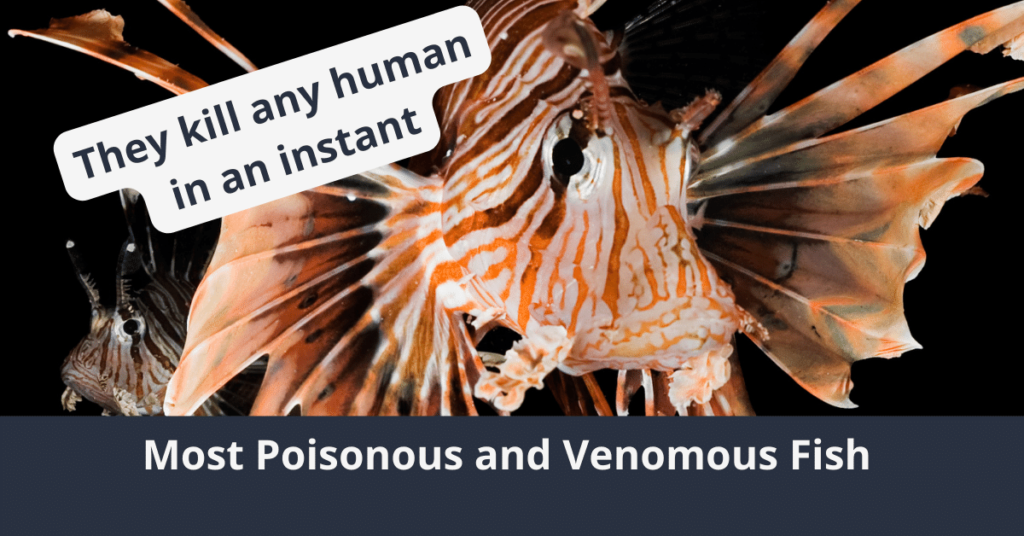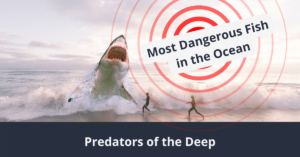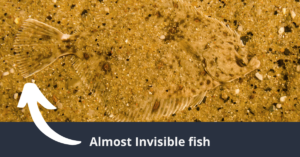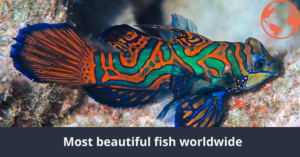Cuando estás sentado en una hermosa playa mirando las olas azules del océano, es fácil olvidar tus problemas y preocupaciones. Sin embargo, si comienza a considerar lo que se encuentra en las profundidades profundas y oscuras de ese mar, es posible que no le guste saber qué se esconde debajo.
El océano contiene algunas de las especies más peligrosocriaturas mortales y desconocidas. Nuestra lista de los peces más venenosos y ponzoñosos del mundo podría hacer que te replantees esas vacaciones en la playa.
Todo lo que aprenderás aquí
- Los 10 peces más venenosos y venenosos
- ¿Conoce la diferencia entre peces venenosos y venenosos?
- Todo lo que necesita saber sobre los peces venenosos y ponzoñosos.
- ¿Cuál es el pez más venenoso?
- ¿Cuáles son los 10 peces más venenosos?
- ¿Qué peces tienen veneno?
- ¿Qué pescado no se puede comer?
- ¿Qué peces de agua dulce son venenosos?
- ¿Qué peces pueden ser letalmente venenosos?
- ¿Qué pez puede paralizarte?
- ¿Puedes sobrevivir al veneno del pez globo?
- ¿Se puede comer un pez globo?
- Peces venenosos y ponzoñosos: Conclusión
Los 10 peces más venenosos y venenosos
A continuación, encontrará algunos de los peces más aterradores que tienen formas únicas y mortales de quitarle la vida a sus presas, junto con la suya. Desde una medusa que puede matarte con un zap hasta un pez camuflado que pueden causar un paro cardíaco, esta lista no es algo que quieras ignorar.
1. Cubozoos
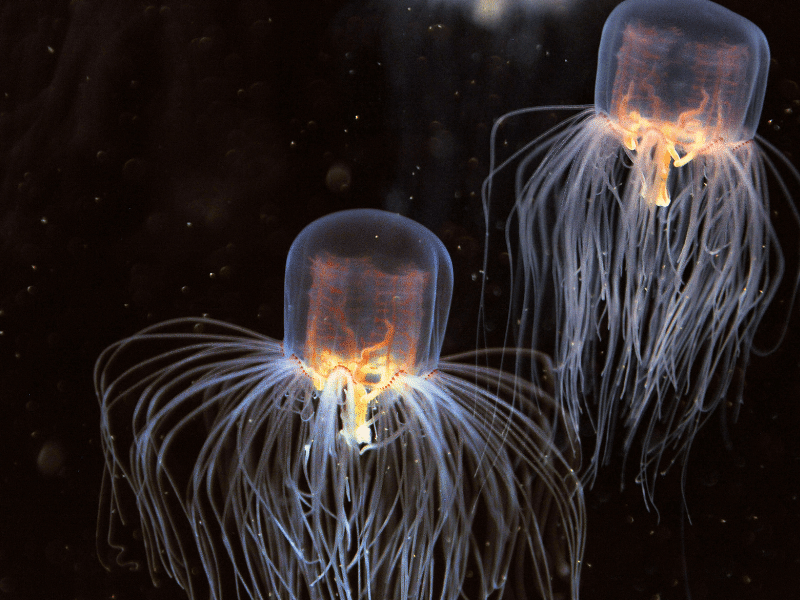
El Cubozoa es más conocido como la medusa de caja. Esta hermosa criatura de aspecto delicado es cualquier cosa menos cuando consideras lo mortal que es. Un animal razonablemente grande, la medusa de caja puede pesar casi cinco libras, y sus muchos tentáculos delicados pueden medir hasta unos diez pies.
Aunque tiene una apariencia casi elegante, el invertebrado en forma de caja se considera uno de los animales más tóxicos del mundo. Con una sola picadura, puede transferir un potente veneno que aturde o mata instantáneamente a su presa.
Una picadura contiene toxinas mortales que atacan directamente el corazón, el sistema nervioso y las células de la piel. Si bien esta picadura se usa más comúnmente para que las medusas ataquen a sus presas en busca de alimento, una picadura para un humano puede ser mortal.
El veneno es tan poderoso y doloroso que la mayoría de las víctimas humanas no pueden llegar a la orilla antes de morir. Es probable que entren en estado de shock y se ahoguen o mueran de insuficiencia cardíaca.
Es posible que una persona sobreviva a una picadura de Cubozoa; sin embargo, uno puede esperar una cicatriz desagradable junto con semanas de dolor intenso. La medusa causa hasta 40 muertes por año en Filipinas.
2. pez globo
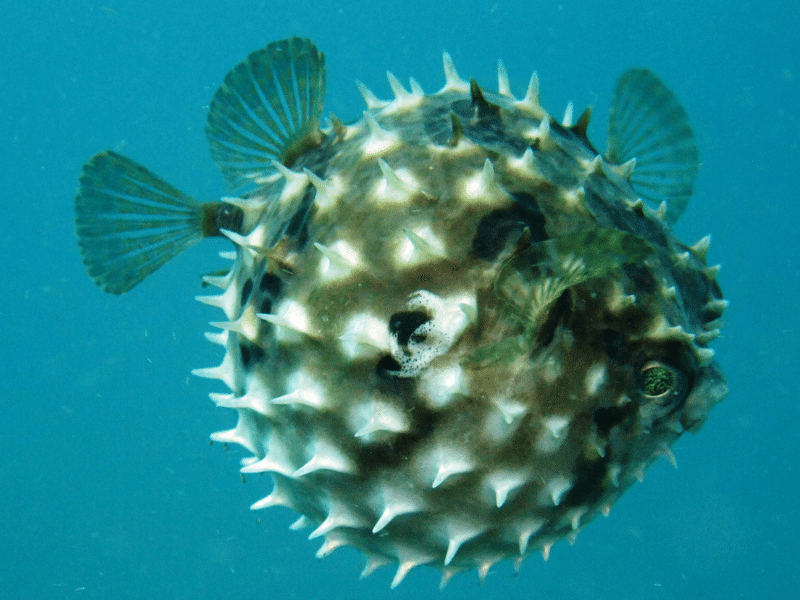
son criaturas marinas distintivas conocidas por su capacidad de inflar su cuerpo, expandiendo una variedad de púas de 360 grados para asustar a sus enemigos. ¿Pero sabías que estos peces pueden ser bastante mortales?
El pez globo contiene una toxina peligrosa llamada tetrodotoxina. Corre por todo el cuerpo del animal y se deriva de bacterias. Esta toxina es hasta 1200 veces más venenosa que el cianuro, y un pez tiene el potencial de matar a 30 humanos adultos, sin antídoto.
El veneno del pez globo puede causar síntomas como vómitos, dificultad para respirar, debilidad muscular y entumecimiento, y puede ser letal si no se trata de inmediato.
Dicho esto, la carne de este extraordinario ser en realidad se considera un manjar. Así es: este pez súper venenoso, mortal para los humanos, también sirve como una comida que la gente disfruta, especialmente en Japón.
Esta comida no solo es costosa, sino que también se necesita un chef autorizado y altamente capacitado para prepararla. Esto se debe a que debe prepararse de manera especializada para garantizar que se eliminen todas las toxinas.
Sin embargo, en muchos otros países es ilegal servir pez globo por riesgo de envenenamiento.
Aunque hay personas capacitadas que son expertas en el tema, todavía hay varias muertes que ocurren por comer este pescado anualmente. Solo un verdadero temerario le daría una oportunidad a esta comida.
3. Pez Cirujano Cebra
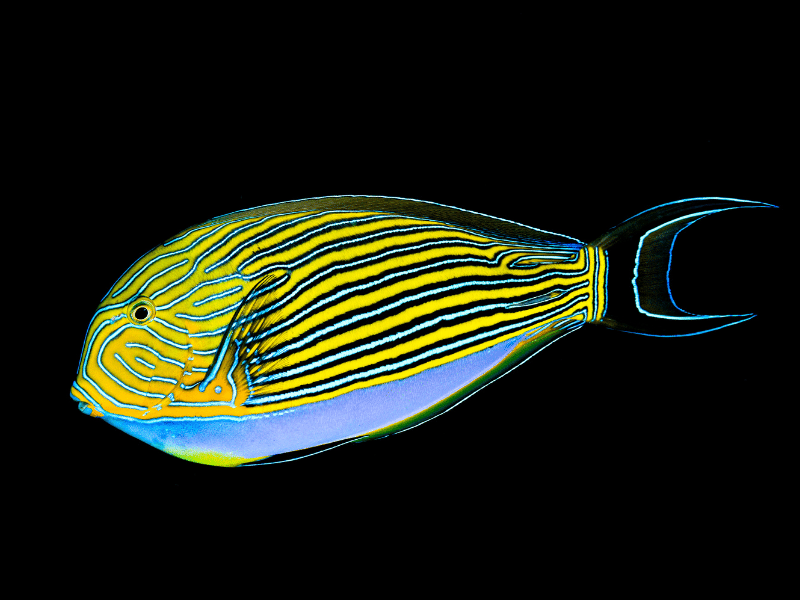
Con rayas que rivalizan con las del mamífero que todos conocemos y amamos, la cebra, este llamativo pez no es tan inocente como parece. Puede que no lo notes desde lejos, pero la criatura marina posee una columna vertebral eréctil que es tan afilada como un bisturí.
La columna vertebral se encuentra en la base de la aleta caudal y contiene un veneno poderoso y peligroso. Corta a cualquier presa que se atreva a acercarse demasiado. De hecho, se sabe que este pez es demasiado agresivo y atacará a cualquier animal o persona que se cruce en su camino.
A pesar de la mortal aleta con forma de cuchillo, el pez cirujano cebra es comestible. Muchos disfrutan el pescado, pero aún existe cierto riesgo de consumirlo. Se sabe que causa un tipo especial de intoxicación alimentaria llamada ciguatera. La ciguatera causa entumecimiento facial, picazón y, en casos graves, hipotensión y ralentización del ritmo cardíaco.
4. Corona de espinas Estrella de mar
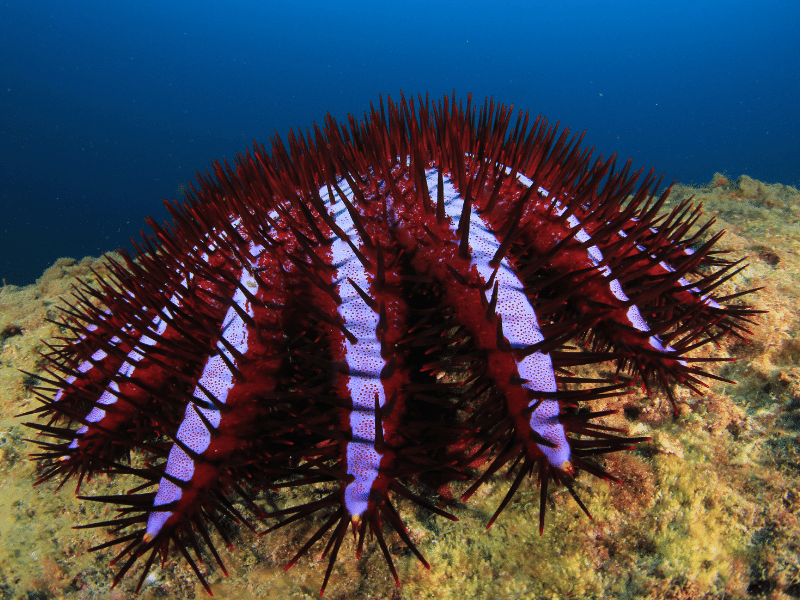
El pez corona de espinas es en realidad una estrella de mar, y es la única estrella de mar en todo el mundo que es venenosa. Apropiadamente llamado, este animal puntiagudo está cubierto de espinas espinosas. Estos accesorios afilados en forma de aguja pueden crecer hasta dos pulgadas, y el pez en sí puede tener entre 7 y 23 brazos.
Una hermosa contribución a los arrecifes de coral, los peces corona de espinas vienen en una amplia variedad de colores. Es posible que vea uno marrón promedio o colores más brillantes como verde y morado con espinas rojas, amarillas o azules.
Si bien no es necesariamente mortal, las espinas de esta estrella de mar pueden afectar la salud humana. Si te pincha uno de ellos, puedes experimentar dolor, náuseas y vómitos. El enrojecimiento y la hinchazón en el sitio de la lesión también son comunes.
5. mantarraya
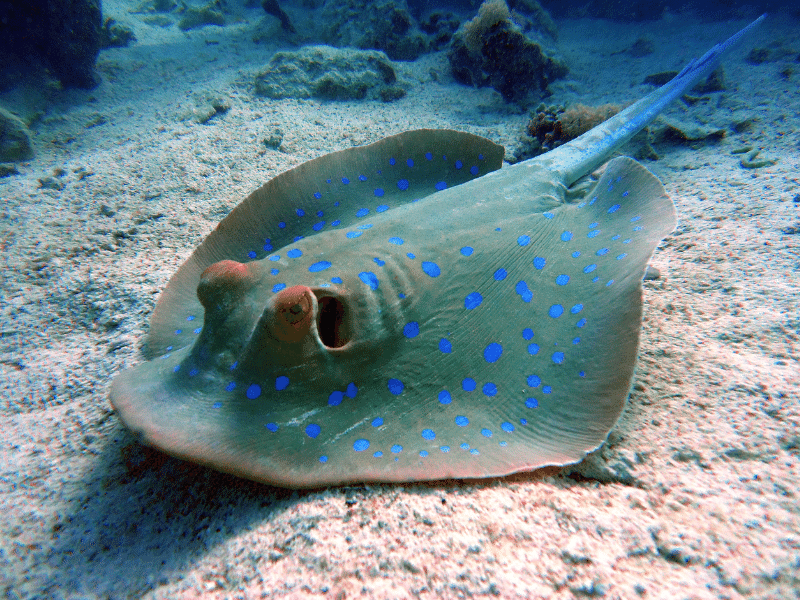
En su mayor parte, las rayas se consideran animales tranquilos y dóciles. No tienen reputación de buscar humanos activamente con la intención de causarles daño.
Sin embargo, tienen una fuerte reacción en términos defensivos y ese ataque puede ser mortal.
Puede que te acuerdes de Cazador de cocodrilos steve irwin. Este cuidador de zoológico australiano, obsesionado con los animales, manejó algunos de los animales más peligrosos del mundo, hasta que fue atacado fatalmente por una raya en un horrible accidente.
La mayoría de las lesiones por rayas ocurren debajo de la rodilla en personas que simplemente estaban en el lugar equivocado en el momento equivocado. En la mayoría de los casos, la muerte es extremadamente rara. Si bien una raya contiene veneno, generalmente no es mortal.
Pero si una raya te golpea en el pecho o el abdomen con su cola afilada, podría matarte. Un golpe directo al corazón sin duda sería fatal. Cualquier otro tipo de perforación puede causar contracciones musculares severas, que son muy dolorosas. También puede causar la muerte de tejidos o células.
6. Cofre
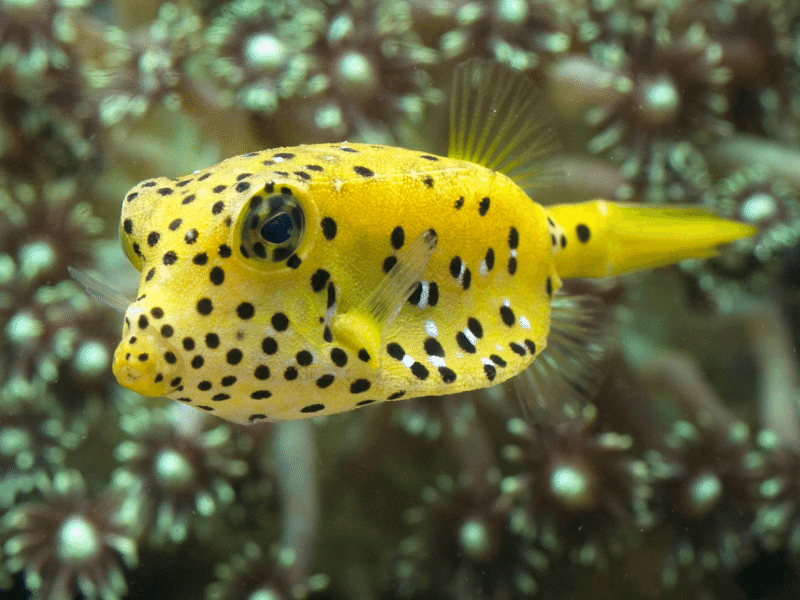
Dada la estrecha relación del pez cofre con el pez globo, no debería sorprender que este pez de aspecto cuadrado también sea venenoso. No saque conclusiones precipitadas aquí: este pez no es tan venenoso como el pez globo. Pero, aún así es mejor mantener la distancia.
La forma extraña y la apariencia moderna del pez cofre lo hacen parecer inofensivo. Su color amarillo brillante es ciertamente llamativo, y luce adorables lunares negros por todas partes.
Sin embargo, este se sabe que los peces excretan un peligroso toxina cada vez que se siente amenazado o asustado. Las células de su piel liberan esta toxina en el agua, que envenenará todo lo que se encuentre en los alrededores.
La toxina puede descomponerse y destruir los glóbulos rojos, lo que puede ser dañino tanto para la vida marina como para los humanos que se acercan demasiado.
7. Candirú

Crédito de la imagen: Ivan Sazima & Jansen Zuanon - https://doi.org/10.1590/0037-8682-0540-2020
El Candiru es un pez nativo de la región del río Amazon. Es asombroso en su similitud con una anguila, ya que cuenta con una apariencia translúcida y no tiene escamas como otros peces.
Este diminuto pez sólo mide unos dos centímetros, por lo que es difícil verlo en el agua. Este pez no posee veneno, pero es bastante mortal. Es un parásito siluro al que le gusta agarrarse a las cavidades branquiales de otros peces, alimentándose de su sangre.
Cuando el Candiru decide convertir a un humano en su presa, en realidad ingresará al cuerpo a través de la uretra de una persona. Una vez dentro, suelta sus cortas espinas, que se adhieren a la víctima y le provocan inflamación. También puede causar hemorragia y eventualmente incluso la muerte.
8. pez león
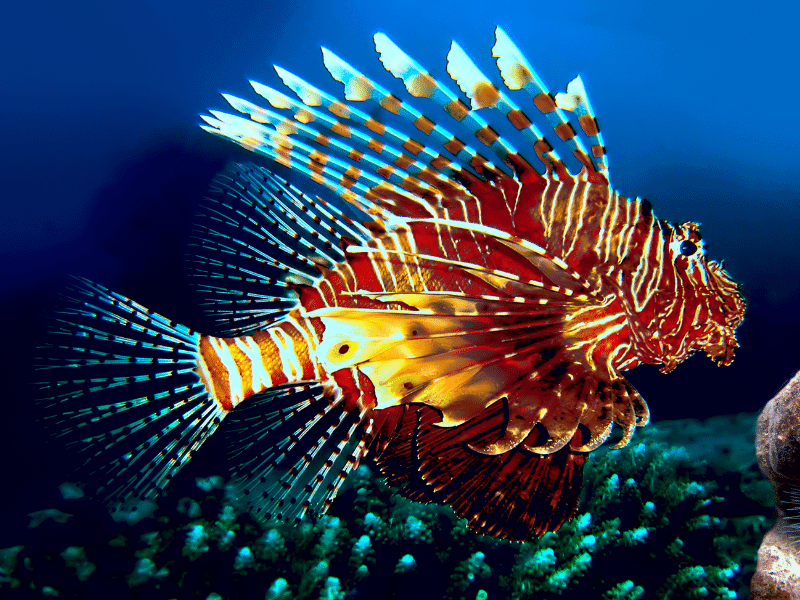
El pez león es bastante impresionante en términos de apariencia. Totalmente cubierto de tiras marrones y blancas, el pez cuenta con grandes aletas ondulantes que fluyen con gracia a través del agua.
Aunque sus aletas son agradables a la vista, no recomendamos acercarse a este gran felino del océano. Un animal altamente tóxico, el pez león tiene veneno dentro de sus espinas dorsales.
Las espinas dorsales pueden inyectar una sustancia tóxica cuando se toca o agarra al pez. El veneno puede causar dolor severo e hinchazón, y puede ser potencialmente mortal en algunos casos.
Afortunadamente, no se sabe que el pez sea agresivo en absoluto. De hecho, en realidad es un pez bastante tímido al que le gusta ocuparse de sus propios asuntos. Las espinas dorsales simplemente actúan como un mecanismo de defensa para protegerlo cuando los depredadores se acercan demasiado.
Es mejor mantenerse alejado de estos tipos: el contacto con esa aleta dorsal produce un fuerte veneno que puede causar dolor intenso, vómitos, dificultad para respirar y, finalmente, parálisis de todos los músculos del cuerpo humano. Una vez que se impacta el músculo cardíaco, el resultado es la muerte.
9. Pez piedra
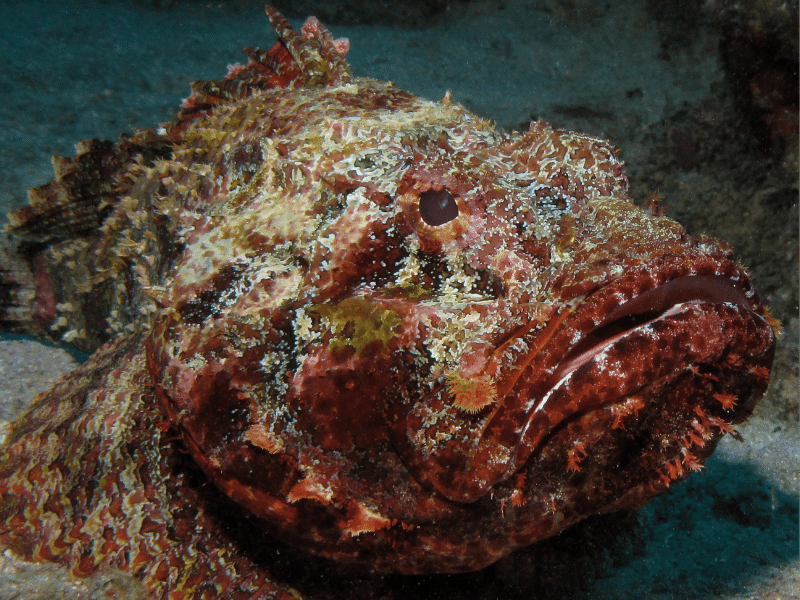
No es un pez especialmente atractivo, pero no se lo digas a la cara. Escondido en el Mar Rojo y el Indo-Pacífico, este pez alberga 13 espinas dorsales que son muy venenosas.
El pez puede ser difícil de detectar, ya que le gusta esconderse en el fondo del mar. Logra un excelente camuflaje enterrándose en la arena o escondiéndose entre las rocas. Cuando todo está dicho y hecho, simplemente parece otra piedra en el océano.
La picadura de una de estas numerosas espinas puede hacer que una persona pierda el conocimiento. Sólo eso ya es una amenaza cuando se está en el agua. Además, el veneno también puede causar un paro cardíaco.
El veneno puede causar dolor intenso, hinchazón y, a veces, provocar la muerte. El pez piedra suele encontrarse en aguas poco profundas cerca de arrecifes de coral, y están bien camuflados. Cuando veas la foto de arriba, ten en cuenta lo cerca que fue tomada, y que no verías los detalles que te hacen reconocer a los peces vivos desde cierta distancia con la máscara de snorkel puesta.
Su excelente camuflaje hace que estos peces venenosos sean muy difíciles de detectar. Los peces piedra no son agresivos y no suelen atacar a los humanos. Sin embargo, pueden ocurrir accidentes cuando la gente los pisa o los toca accidentalmente mientras nadan o bucean.
(También puede estar interesado en leer acerca de la Los peces más peligrosos del océano)
10. Pez víbora
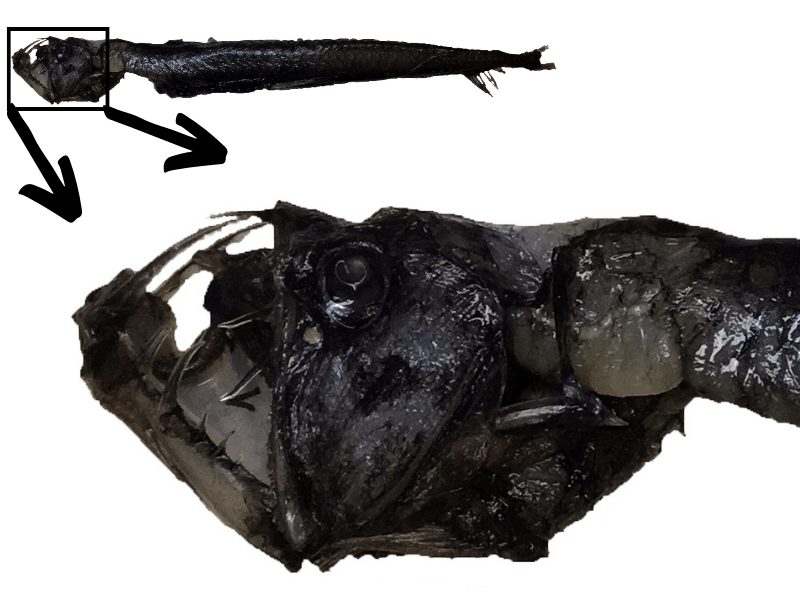
Mucha gente teme las profundidades del océano porque son oscuras y relativamente desconocidas. Sin embargo, algunos temen esta región del mundo por lo que sí conocemos, como el venenoso pez víbora.
El pez que habita en aguas profundas tiene una apariencia desagradable, lleno de dientes retorcidos e irregulares que llegan tanto dentro como fuera de su boca.
Su apariencia es suficiente para asustar a cualquiera que se encuentre con este pez, pero también es uno de los peces más venenosos que puedes encontrar en el océano.
El pez víbora es más conocido por su órgano productor de luz, que cuelga de un sedal sobre su cabeza. La luz sirve para atraer a otros peces. El pez víbora se queda completamente quieto mientras su presa se acerca a la luz, y entonces ataca.
Si bien es extraordinariamente venenoso y mortal, este pez vive mucho más profundo de lo que probablemente jamás irás al océano. Además, en realidad solo está interesado en su próxima comida, no en los humanos.
Bonificación: 11. Caracol Cono
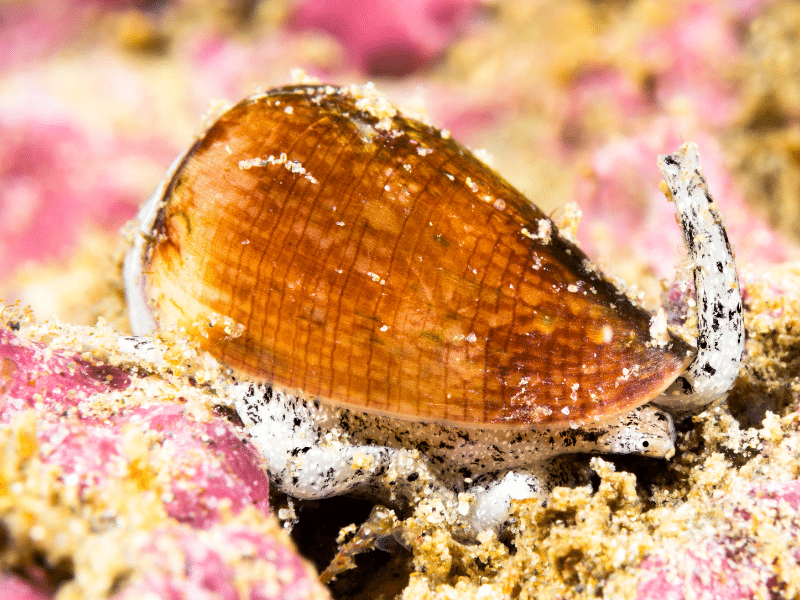
los caracol cono no es un pez, pero sin embargo completa muy bien esta lista. Se trata de un caracol marino que habita en aguas tropicales y subtropicales de todo el mundo y puede encontrarse en muchos colores. Tiene un diente venenoso en forma de arpón que utiliza para capturar a sus presas. El veneno de algunas especies de caracol cono es muy tóxico y puede causar lesiones graves o la muerte si no se trata al instante.
Por suerte, los caracoles cono no son agresivos. Los caracoles venenosos no atacan a los humanos a propósito, pero pueden ocurrir accidentes cuando la gente los pisa accidentalmente.
(¿Pescando en Aguas Dulces? Debes saber sobre la Los peces de agua dulce más peligrosos)
¿Conoce la diferencia entre peces venenosos y venenosos?
Venenoso y venenoso suelen utilizarse indistintamente, pero en realidad se refieren a distintas formas en que los animales pueden dañar al ser humano.
Un animal venenoso tiene un órgano o glándula especial que produce una sustancia tóxica que inyecta en su presa o atacante mediante una mordedura, picadura u otro medio de administración. El veneno actúa alterando el funcionamiento normal de las células y tejidos del organismo, y puede causar diversos síntomas, desde dolor leve e hinchazón hasta enfermedades graves o la muerte.
En resumen, ¡un pez venenoso te muerde!
Por otro lado, un animal o una planta venenosos contienen toxinas que son nocivas cuando se ingieren o entran en contacto con la piel. El veneno actúa siendo absorbido por el organismo y causando daños cuando alcanza determinados órganos o sistemas. Los animales y plantas venenosos carecen de un sistema especial de administración de sus toxinas y no las inyectan activamente en otros organismos.
Resumiendo, ¡te comes un pez venenoso!
En resumen, los animales venenosos utilizan un sistema de administración para inyectar toxinas en sus presas o atacantes, mientras que los animales o plantas venenosos contienen toxinas que son nocivas cuando se ingieren o entran en contacto con la piel.
Todo lo que necesita saber sobre los peces venenosos y ponzoñosos.
¿Cuál es el pez más venenoso?
El pez más venenoso es el pez piedra. Se encuentra en aguas de los océanos Pacífico e Índico, y tiene espinas venenosas en el lomo que pueden inyectar una sustancia tóxica cuando se pisa o se toca al pez.
El veneno del pez piedra es muy tóxico y puede causar lesiones graves o la muerte si no se trata de inmediato.
¿Cuáles son los 10 peces más venenosos?
Algunos ejemplos de peces venenosos son el pez globo, el pez león rojo y el caracol cono.
los pez globo, también conocido como fugues un tipo de pez muy venenoso debido a una toxina llamada tetrodotoxina que se encuentra en su piel, músculos y órganos internos.
El rojo pez león es una especie de pez originaria de la región indopacífica, pero se ha introducido en las aguas del Caribe y del océano Atlántico occidental. Tiene espinas venenosas en el lomo y las aletas que pueden inyectar una sustancia tóxica cuando se toca o agarra al pez.
los caracol cono es un tipo de caracol marino que se encuentra en aguas tropicales y subtropicales de todo el mundo. Tiene un diente venenoso en forma de arpón que utiliza para capturar a sus presas. El veneno de algunas especies de caracoles cono es muy tóxico y puede causar daños graves o incluso la muerte si no se trata de inmediato. Los caracoles cono no son agresivos y no suelen atacar a los humanos, pero pueden ocurrir accidentes. Cuando la gente los toca o los pisa accidentalmente, hay que tratarlos de inmediato.
¿Qué peces tienen veneno?
Muchos tipos de peces tienen veneno, que utilizan para defensa o a capturar presas. El veneno es una sustancia tóxica producida por un animal y suministrada a su presa o atacante mediante una mordedura, picadura u otro medio de ataque. inyección. El veneno actúa alterando el funcionamiento normal de las células y los tejidos del organismo, y puede causar diversos síntomas. Los efectos van desde el dolor leve y la hinchazón hasta la enfermedad grave o la muerte. Algunos ejemplos de peces venenosos son pez piedra, rayasweeverfish, y pez león.
¿Qué pescado no se puede comer?
Hay varios tipos de pescado que no pueden comerse debido a las toxinas que contienen. Comer estos pescados puede causar enfermedades graves o la muerte. Algunos ejemplos de pescados venenosos que no deben comerse son el pez globoEl pez leóny el pez piedra.
¿Qué peces de agua dulce son venenosos?
Hay algunas especies de pescado de agua dulce que son venenosos, como la raya y el pez weever. Estos peces viven en ríos, arroyos y lagos de regiones tropicales y subtropicales.
¿Qué peces pueden ser letalmente venenosos?
Algunos pescados pueden ser letalmente venenosos si los comes, ya que contienen toxinas perjudiciales para el ser humano. Estas toxinas pueden causar enfermedades graves o la muerte si no son tratadas inmediatamente por un médico. Algunos ejemplos de peces que pueden ser letalmente venenosos son los siguientes pez globo y el caracol cono.
¿Qué pez puede paralizarte?
Hay varios tipos de peces que pueden producir toxinas que pueden causar parálisis en los seres humanos. Estas toxinas actúan alterando el funcionamiento normal de los músculos y nervios del cuerpo, lo que provoca debilidad muscular y dificultad para moverse. Algunos ejemplos de peces que pueden paralizar a los humanos son el pez globo y el pez piedra.
¿Puedes sobrevivir al veneno del pez globo?
Es posible sobrevivir a una intoxicación por pez globo, pero puede ser muy grave y requiere tratamiento médico inmediato. El veneno del pez globo puede causar síntomas como vómitos, dificultad para respirar, debilidad muscular y entumecimiento. Si no se trata, puede provocar el coma o la muerte. La gravedad de los síntomas y el riesgo de muerte dependen de la cantidad de veneno ingerida. Hay que buscar ayuda profesional de inmediato para aumentar las posibilidades de sobrevivir al veneno del pez globo, tras su ingestión.
¿Se puede comer un pez globo?
El pez globo, también conocido como pez globo o fugu, es un tipo de pescado venenoso si no se prepara adecuadamente. En algunos países, se considera un manjar y lo preparan cocineros especialmente formados que saben cómo eliminar las partes tóxicas del pescado. En otros países, es ilegal servir pez globo debido al riesgo de envenenamiento.
En general, no es seguro comer pez globo a menos que haya sido preparado por un profesional cualificado. El pez globo contiene una toxina llamada tetrodotoxina que se encuentra en su piel, músculos y órganos internos. Esta toxina es extremadamente venenoso y puede causar síntomas como vómitos, dificultad para respirar, debilidad muscular y entumecimiento, y puede ser mortal si no se trata a corto plazo.
Sólo algunas partes del pez globo son seguras para el consumo, y deben ser extraídas cuidadosamente por un cocinero cualificado para evitar intoxicaciones. Así pues, comer pez globo es arriesgado, ya que es difícil saber cuánta toxina hay todavía en el plato de pescado ya preparado.
Peces venenosos y ponzoñosos: Conclusión
Ya sea por una picadura directa al corazón de una inocente comida en un país extranjero, cualquiera de estas criaturas extremadamente venenosas y ponzoñosas podría ser lo último que encuentre con vida. Sin duda, aún podemos disfrutar de la belleza, el misterio y la intriga de las océano - pero a veces es mejor hacerlo desde lejos.

